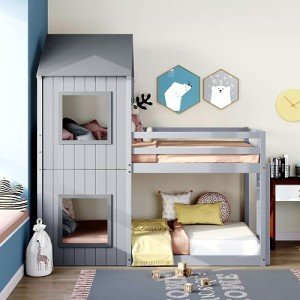A Comprehensive Guide to Children's Bunk Beds: Styles, Benefits, and Safety Considerations
Bunk beds have ended up being a popular option for families looking to take full advantage of space and offer a fun sleeping environment for kids. With their special style, they use an imaginative and practical solution for shared bed rooms, playrooms, and even guest accommodation. This post checks out the various styles of children's bunk beds, their benefits, security considerations, and answers some regularly asked questions.
The Allure of Bunk Beds
Kid's bunk beds are more than just space-saving structures; they are likewise a gateway to daring dreams and imaginative play. Below is a comprehensive assessment of their many benefits.
Benefits of Bunk Beds
- Space-Saving: Bunk beds efficiently make use of vertical space, making them a perfect option for smaller rooms.
- Playful Design: Many bunk bed designs consist of slides, tents, and themed elements, sparking imagination and enjoyment.
- Partner Sharing: Bunk beds are perfect for siblings sharing a space or accommodating sleepovers.
- Versatile Use: Some models can be separated into two individual beds, providing flexibility as kids grow.
- Storage Options: Many bunk beds come with integrated drawer storage or racks, even more enhancing their practicality.
Styles of Children's Bunk Beds
The range of bunk beds offered today accommodates different choices and requirements. Below is an introduction of some popular styles.
| Design | Description | Best For |
|---|---|---|
| Standard Bunk Bed | A conventional design including one bed stacked above another. | Brother or sisters sharing a space. |
| Loft Bed | Similar to a bunk bed without the bottom bunk, enables a work area or play area below. | Restricted space for play/desk. |
| L-Shaped Bunk Bed | 2 beds organized in an L-shape, frequently with additional areas for storage or play. | Special room layouts. |
| Twin Over Full | A twin bed over a complete bed, accommodating various sleep needs. | Growing kids and teens. |
| High Sleeper | Stands even greater than a loft bed, generally featuring a desk or play location below. | Older kids requiring more play/desk space. |
| Tent Bunk Bed | Bunk beds with a canopy or tent-like structure, developing a relaxing, enjoyable space. | Active and creative children. |
Key Features to Consider
When choosing the best bunk bed for kids, the following features deserve considering:
- Material: Bunk beds can be made from wood, metal, or a combination. Each has its distinct visual and sturdiness.
- Weight Capacity: Always confirm the weight limitation of the bunk bed to guarantee it can accommodate your children securely.
- Safety Rails: Ensure the leading bunk has strong rails to prevent falls.
- Ladder Security: A properly designed ladder should offer easy and safe access to the upper bunk.
- Finishing: Ensure any finishes are non-toxic and safe for kids.
Security Considerations
Safety is critical when it concerns kids's bunk beds. The following guidelines must be abided by:
- Age Appropriateness: Generally, children under six years of ages need to not sleep in the upper bunk due to security dangers.
- Strong Construction: Ensure the frame and materials are solid and can support the weight without drooping.
- Regular Maintenance: Periodically look for loose screws, bolts, or other parts that might require tightening up.
- Clear Play Area: Keep the location around the bunk bed devoid of toys and barriers to lessen tripping threats.
Setting Rules for Safe Use
Developing guidelines for bunk bed use will assist make sure security:
- Limit Jumping and Climbing: Children need to be recommended versus leaping from the top bunk and climbing on the sides.
- Monitoring Sleepovers: Monitor young guests while they are utilizing the bunk bed for the first time.
- Inform on Ladder Use: Teach how to utilize the ladder securely, emphasizing the significance of dealing with the ladder when climbing up or down.
Regularly Asked Questions
1. What age is suitable for a child to sleep in the leading bunk?
A lot of makers advise that children need to be at least six years of ages to oversleep the upper bunk. This standard is created to mitigate the threat of falls.
2. Can bunk beds be tailored?
Yes, numerous manufacturers offer customizable choices, including colors, products, and extra features like drawers or desks.
3. Are bunk beds safe for weight?
Bunk beds have weight limits, generally varying from 200 to 400 pounds, depending upon the design and material. Constantly examine the producer's specifications.
4. How do I preserve and clean up a bunk bed?
Frequently look for loose parts, keep the bed clean by wiping down surface areas, and ensure the bedding is fresh to promote a safe and sanitary sleep environment.
5. Can bunk beds be separated into private beds?
Many bunk beds come with an option to separate them into two individual beds, providing long-term adaptability.
Kid's bunk beds are more than mere furniture; they are a functional, flexible, and creative part of a child's space. With various styles readily available and many security factors to consider to bear in mind, parents can choose the ideal bed that fits their space, meets their kids's requirements, and instills a sense of adventure. By comprehending her response , styles, and security procedures connected with bunk beds, households can produce a wonderful and safe and secure sleeping environment for their children. Whether for brother or sisters sharing a space or space-saving services, bunk beds remain a cherished choice for numerous homes.

